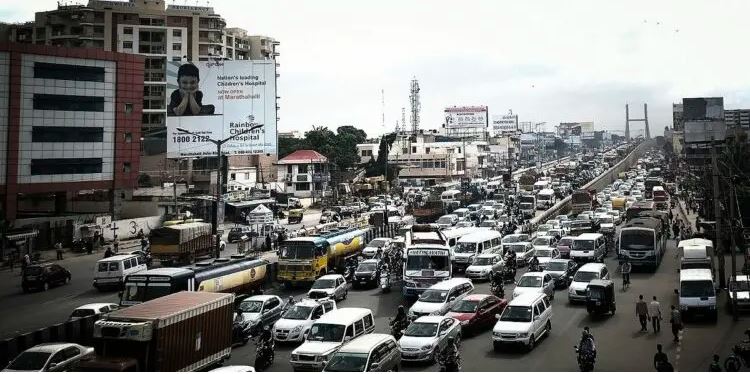AI-enabled cameras will determine traffic volume and density, and calculate the time it would take to clear a particular wave of vehicles.

Peak Hour Traffic in Bengaluru
If all goes well, at least 163 prominent traffic junctions in the city will be upgraded with the latest adaptive traffic signal systems — based on Artificial Intelligence (AI) — developed by CDAC, a Research and Development (R&D) institute and development centre under the Union government.
“This AI-based adaptive traffic signal system can read the volume of vehicles on a stretch of road and calculate the time required to allow it to pass through a particular signal,” Special Commissioner MA Saleem told South First.
“It can also pick up signals from devices fitted to certain emergency vehicles like ambulances, fire and police vehicles, and change to green light to allow their movement on priority,” he added.
“This would be something similar to the traffic signal system in Manhattan, New York, where the distance between two signal junctions is less than 100 metres,” said Saleem.
The consultant on the project has prepared a Detailed Project Report (DPR) and submitted it to the government, he added.
“Now it is in the procurement process with KRDCL (Karnataka Road Development Corporation Limited). And, if all goes well, 163 traffic junctions in the city will be upgraded in the first phase in a matter of three-four months,” said Saleem.
These 163 junctions are a part of a dozen corridors in the city, said another senior police officer.
Delving into the technology, Saleem explained that the AI-based adaptive signal system reads the volume of vehicles on a particular stretch of a carriageway and calculates the time that it can allow them to pass through the signal.
AI-enabled cameras determine traffic volume and density, calculate the time it would take to clear a particular wave of traffic, and then accordingly manage the signal lights.
A countdown timer in the AI-enabled device will help vehicles save fuel and will manage the changing of signals for smooth movement of traffic at a given junction.
“The machine-learning technology will decide how much time it would allow the vehicles to pass through and manage the traffic movement at the entire signal on its own. This adaptive signal system will also be interconnected with a series of traffic signals at a particular stretch of a road so that the system could calculate the reduced waiting time for commuters at a particular signal,” said a senior police officer who is also a technical expert.
Moreover, it also uses signal receptors which pick up signals from devices that are connected to certain vehicles — emergency vehicles such as ambulances, fire and police.
Whenever these vehicles reach within 100-200 metres of the traffic signal, the adaptive system picks up the signal and changes to green light, allowing them to pass through.
“Saving lives are our priority,” said Saleem, adding: “At present, there is a dedicated staff in each shift: A traffic policeman monitors ‘108’ ambulance movements throughout the city and manages their free movement by coordinating with the cops on the field.”
Asked what the “Golden Hour” would mean to the Bengaluru Traffic Police, especially with the bumper-to-bumper traffic in the city, Saleem said: “We somehow are able to manage and find a way to keep ambulances going, whether it is at a traffic signal or if it has to make its way through dense traffic.
He added: “However, of late, we do not get to hear any complaints or instances that ambulances are getting stuck at traffic signals or traffic gridlocks, and that is what we strive for.”
There is a control room available for “108” ambulances, but ambulances of private hospitals either need to come on board with the “108” control room or have to tie up with the Health Department to get into this programme.
Bengaluru’s traffic woes have hit global headlines many times, especially due to the poor infrastructure that came to the fore after the rains and floods washed away asphalted roads in several parts of the city, and potholes and craters affected traffic movement in Bengaluru.
There were a few accidental deaths due to potholes along with sudden road caving-in instances that added fuel to the fire.
It was at this time in November last year that, in a desperate attempt to overhaul the traffic management system in Karnataka’s capital city, two IPS officers — Additional Director General of Police (ADGP) MA Saleem, and Deputy Inspector General (DIG) MN Anucheth — were roped in by the Basavaraj Bommai government.
Soon after Saleem and MN Anucheth took over, they identified several congestion spots and bottleneck junctions across the city and decongested them in whatever ways they found amenable.
There were several stretches of Ring Roads in the city that were connected to state highways that had heavy vehicle movement at all times, causing traffic congestion — especially during peak hours.
Saleem not only staggered the timings of the entry of heavy vehicles into and out of the city but also redirected them through separate approach routes, not allowing them on the main carriageway the light motor vehicles often use.

Apr 20, 2024

Apr 20, 2024

Apr 20, 2024

Apr 20, 2024

Apr 20, 2024